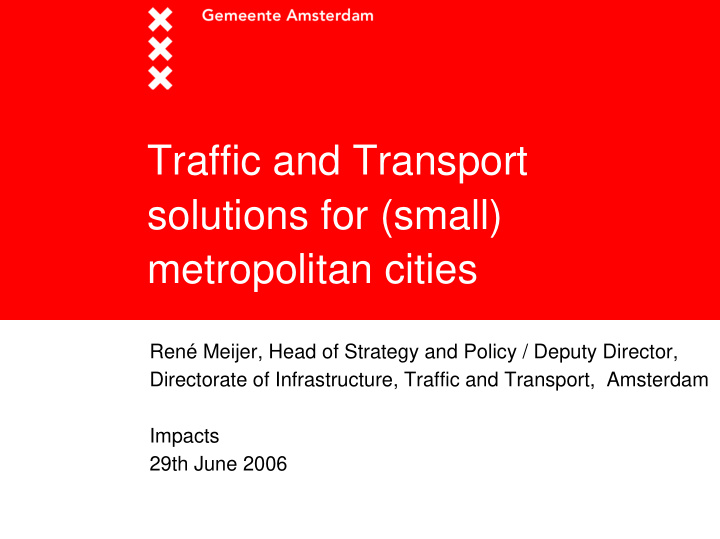



Traffic and Transport solutions for (small) metropolitan cities René Meijer, Head of Strategy and Policy / Deputy Director, Directorate of Infrastructure, Traffic and Transport, Amsterdam Impacts 29th June 2006
Stockholm / Amsterdam, a comparison • Stockholm city: 7 6 5 ,0 0 0 Population city of Am sterdam : 7 4 5 ,0 0 0 • Region: 1 .8 m illion Population region: 1 .5 m ( excluding Haarlem ) • • 8 1 5 ,0 0 0 people in em ploym ent Num ber of residences: 7 0 0 ,0 0 0 • 8 0 0 ,0 0 0 residences Labour force: 9 0 0 ,0 0 0 • A surface area of about 6 ,5 0 0 km 2 Cars ( ow ners) in Am sterdam : 2 1 1 ,0 0 0 • 1 8 0 km from north to south Mileage in region: 2 5 billion km / year • 2 6 m unicipalities
Accessibility – Traditional Instruments A lot of European cities, facing serious traffic problems try to improve accessibility with: � Parking policy � Free bus lanes � Encouraging use of bicyles � Encouraging use of public transport � Dynamic Traffic Management � Park and Ride facilities � Road charging system
Contents Part 1 Traditional instruments in Amsterdam � Parking policy � On-line information on parkingsites � Dynamic traffic management � Network approach Part 2 Amsterdam’s reasons for road pricing Part 3 Speeding up national implementation
Part 1 Traditional instruments in Amsterdam
Parking policy � High fees (€ 4,40 - € 1,10) � Strict enforcement � ... But it does work
key figures (50 km 2 of parking policy) � 110,000 on-street paid parking places � 25,000 on-street paid parking in historic centre � 150,000 visitors on a working day � 15 public car-parks (7,351 spaces) � 7 garages (3,000 spaces) in the historic centre � 3 (1,162 spaces) of above in public ownership � 9 garages (3,835 spaces) in private ownership � 4 P+R garages (1,150 spaces), 1 P+R in development � 3 garages (2,380 spaces) operated by South East city district (public private cooperation)
Tariffs 2000-2006 A + - tariff (€) Year A-tariff (€) B-tariff (€) C-tariff (€) 10 cent (€) 2000 2.40 1.47 0.80 2001 2.60 1.60 0.80 2002 2.80 1.70 0.90 2003 3.00 1.80 0.90 2004 3.20 1.90 1.00 2005 3.40 2.00 1.10 2006 4.40 3.40 2.00 1.10 0.10
On-line information on parking sites at www.bereikbaar.amsterdam.nl
On Saturday afternoon: little chance of available parking sites
Dynamic Traffic management
Dynamic Parking Routes (city centre)
DTM on Motorways (events in stadium)
V e rk e e rsn e tw e rk N oord- H olla n d Prioriteiten regelstrategie Network approach Prioriteit 1 Prioriteit 2 Prioriteit 3 • Ring A10 is most crucial • On less import roads: buffering • Dynamic traffic management • Agreements with other road administrators
Part 2 Amsterdam reasons for road pricing
Reasons for road pricing in Amsterdam � Accessibility, economic attraction � Quality of life, reducing air pollution � Network measurments/ dynamic traffic control � Funding for new infrastructure either investments in road or public transport
Amsterdam and Accessibilty � Traffic situation during peak rush hour in 2010 � (Traffic demand versus capacity) Almere
Amsterdam & Almere, twin cities Source: city of Almere 2003
And last but not least : air quality � Air quality in big cities is deteriorating � Recent research shows air pollution is threatening � Air quality in a city is part of the quality of life � Due to new EU standards for NOx,PM10: restrictions on building new houses and roads
Potential exceeding of the limits for NO 2 .
The product � Starting point and terms of reference � Analysis of problem � Analysis of bottlenecks
Overview air quality NO 2 (bad year) No measures taken Key: exceeding planned limit not exceeding norm NO 2 exceeding marginal value
Overview Air Quality NO 2 (good year) No measures taken Key: exceeding planned limit Not exceeding norm NO 2 exceeding marginal value
Overview Air Quality NO 2 (good year) all measures Key: exceeding planned limits not exceeding norm NO 2 exceeding marginal value
Part 3 Speeding up national implementation
Road pricing, part of a integrated plan
National policy: road pricing in 2012 ... � Spring 2005 : advice from National platform on road pricing � Leading principle: a price (not a charge) for road use � start with the toll on new roads and bridges …. � …. final stage: a kilometre price (2012): - abolishment of road taxes - differentiated charges, time, place and environmental characteristics � Programme for next 18 months: preparing policy choices and monitoring costs of satellite-based system
Planning for nationwide introduction in 2012 2005 2006 2007 2008 2009 2012 Km-price = go/no go N Price per kilometre O draft bill T Preparing for A policy choices M Implementation O Including tax issues B I Realisation of public component L I Cost Cost Cost T monitor monitor monitor E I Requirement T Specifications P Tender A R Realisation of private component T 4 Social implementation and communication
Lessons learnt from Impacts 2005 When it comes to the question of introducing road pricing � Political courage � Proven technology � ‘simple’ scheme � Try to be fair � Communicate it well � Dare to be the first in the country
Moving on in Amsterdam.... � Newly-elected Labour city government (spring 2006) � Road pricing is part of city plan � Road pricing should be a cooperative decision for the region � National policy opens perspectives for implementation
As Impacts colleagues Considering the facts that Urban Access � is important for Metropolitan Areas � essential for social functioning and economic growth Agree � on sense of urgency � Lack of alternatives � The results in London and Stockholm have been impressive
Recommend
More recommend